The Impact of Environmental Variability on Cotton Fiber Quality: A Comparative Analysis of Primary Cotton-Producing Regions in Türkiye
Abstract
1. Introduction
2. Materials and Methods
2.1. Data Collection
2.2. Growth Stage Estimation
- Emergence: 13 °C;
- First square: 260 °C;
- First flower: 454 °C;
- First open boll: 927 °C;
- Maturation: 1218 °C.
2.3. Data Analysis
3. Results
4. Discussion
5. Conclusions
Supplementary Materials
Author Contributions
Funding
Data Availability Statement
Conflicts of Interest
References
- Liu, S.; Gordon, S.; Stiller, W. Are yarn quality prediction tools useful in the breeding of high yielding and better fibre quality cotton (Gossypium hirsutum L.)? J. Cotton Res. 2023, 6, 18. [Google Scholar] [CrossRef]
- Bradow, J.M.; Davidonis, G.H. Quantitation of fiber quality and the cotton production-processing interface: A physiologist’s perspective. J. Cotton Sci. 2000, 4, 34–64. [Google Scholar]
- Van Der Sluijs, M.H. Effect of nitrogen application level on cotton fibre quality. J. Cotton Res. 2022, 5, 9. [Google Scholar] [CrossRef]
- Hussain, A.; Sajid, M.; Iqbal, D.; Sarwar, M.I.; Farooq, A.; Siddique, A.; Khan, M.Q.; Kim, I.S. Impact of novel varietal and regional differences on cotton fiber quality characteristics. Materials 2022, 15, 3242. [Google Scholar] [CrossRef]
- Food and Agriculture Organization of the United Nations. FAOSTAT Statistical Database; FAO: Rome, Italy, 2024; Available online: https://fao.org/faostat/en/data/QCL (accessed on 1 April 2024).
- Balci, S.; Cinar, V.M.; Unay, A. Fiber Quality Characteristics of Cotton (Gossypium hirsutum L.) in Main Production Areas of Aegean Region. Curr. J. Appl. Sci. Technol. 2022, 41, 36. [Google Scholar] [CrossRef]
- United States Department of Agriculture, Foreign Agricultural Service. Cotton and Products Annual Report; Report Number: TU2021-0016; USDA: Washington, DC, USA, 2021.
- Karapinar, B.O.; Erdem, N. Comparison of quality characteristics of yarns spun from Aegean cotton fibres and their mixtures with South-east Anatolian cotton fibres. Fibres Text. East. Eur. 2003, 11, 26–29. [Google Scholar]
- Çopul, S.; Gençsoylu, İ. Aydın ili ikinci ürün pamukta (Gossypium hirsutum L.) farklı azot dozlarının verim, verim komponentleri ve lif kalite özellikleri üzerine etkisi. Adnan Menderes Üniv. Ziraat Fakültesi Dergisi 2020, 17, 271–279. [Google Scholar] [CrossRef]
- Paterson, A.; Saranga, Y.; Menz, M.; Jiang, C.X.; Wright, R. QTL analysis of genotype× environment interactions affecting cotton fiber quality. Theor. Appl. Genet. 2003, 106, 384–396. [Google Scholar] [CrossRef]
- Ulloa, M.; De Santiago, L.M.; Hulse-Kemp, A.M.; Stelly, D.M.; Burke, J.J. Enhancing Upland cotton for drought resilience, productivity, and fiber quality: Comparative evaluation and genetic dissection. Mol. Genet. Genom. 2020, 295, 155–176. [Google Scholar] [CrossRef] [PubMed]
- Manan, A.; Zafar, M.M.; Ren, M.; Khurshid, M.; Sahar, A.; Rehman, A.; Firdous, H.; Youlu, Y.; Razzaq, A.; Shakeel, A. Genetic analysis of biochemical, fiber yield and quality traits of upland cotton under high-temperature. Plant Prod. Sci. 2022, 25, 105–119. [Google Scholar] [CrossRef]
- Darawsheh, M.K.; Beslemes, D.; Kouneli, V.; Tigka, E.; Bilalis, D.; Roussis, I.; Karydogianni, S.; Mavroeidis, A.; Triantafyllidis, V.; Kosma, C.; et al. Environmental and regional effects on fiber quality of cotton cultivated in Greece. Agronomy 2022, 12, 943. [Google Scholar] [CrossRef]
- Beegum, S.; Reddy, V.; Reddy, K.R. Development of a cotton fiber quality simulation module and its incorporation into cotton crop growth and development model: GOSSYM. Comput. Electron. Agric. 2023, 212, 108080. [Google Scholar] [CrossRef]
- Campbell, B.; Jones, M. Assessment of genotype× environment interactions for yield and fiber quality in cotton performance trials. Euphytica 2005, 144, 69–78. [Google Scholar] [CrossRef]
- Abd El Samad, H.; El Hosary, A.; Shokr, E.S.; El-Badawy, M.; Eissa, A.; El Hosary, A. Selecting high yield and quality cotton genotypes using phenotypic and genotypic stability statistics. Egypt. J. Plant Breed. 2017, 21, 642–653. [Google Scholar]
- Pettigrew, W. The effect of higher temperatures on cotton lint yield production and fiber quality. Crop Sci. 2008, 48, 278–285. [Google Scholar] [CrossRef]
- Saini, D.K.; Impa, S.; McCallister, D.; Patil, G.B.; Abidi, N.; Ritchie, G.; Jaconis, S.; Jagadish, K.S. High day and night temperatures impact on cotton yield and quality—Current status and future research direction. J. Cotton Res. 2023, 6, 16. [Google Scholar] [CrossRef]
- Ul-Allah, S.; Rehman, A.; Hussain, M.; Farooq, M. Fiber yield and quality in cotton under drought: Effects and management. Agric. Water Manag. 2021, 255, 106994. [Google Scholar] [CrossRef]
- Yagmur, B.; Gurel, A.; Oren, Y.; Izcl, B.; Edreva, A.; Hakerlerler, H.; Hayta, S.; Akdemir, H.; Yilaiz-Aktas, L. Effects of different drought applications and potassium doses on cotton yield and fiber quality. Res. J. Agric. Environ. Manag. 2014, 3, 60–67. [Google Scholar]
- Basal, H.; Dagdelen, N.; Unay, A.; Yilmaz, E. Effects of deficit drip irrigation ratios on cotton (Gossypium hirsutum L.) yield and fibre quality. J. Agron. Crop Sci. 2009, 195, 19–29. [Google Scholar] [CrossRef]
- Bange, M.P.; Constable, G.A.; Johnston, D.B.; Kelly, D. A method to estimate the effects of temperature on cotton micronaire. J. Cotton Sci. 2010, 14, 164–172. [Google Scholar]
- Luo, Q.; Bange, M.; Johnston, D. Environment and cotton fibre quality. Clim. Change 2016, 138, 207–221. [Google Scholar] [CrossRef]
- Lokhande, S.; Reddy, K.R. Quantifying temperature effects on cotton reproductive efficiency and fiber quality. Agron. J. 2014, 106, 1275–1282. [Google Scholar] [CrossRef]
- Gipson, J.; Joham, H. Influence of night temperature on growth and development of cotton (Gossypium hirsutum L.). I. Fruiting and Boll Development. Agron. J. 1968, 60, 292–295. [Google Scholar] [CrossRef]
- Hejnák, V.; Tatar, Ö.; Atasoy, G.; Martinková, J.; Çelen, A.; Hnilička, F.; Skalickỳ, M. Growth and photosynthesis of Upland and Pima cotton: Response to drought and heat stress. Plant Soil Environ. 2015, 61, 507–514. [Google Scholar] [CrossRef]
- Lysenko, E.A.; Kozuleva, M.A.; Klaus, A.A.; Pshybytko, N.L.; Kusnetsov, V.V. Lower air humidity reduced both the plant growth and activities of photosystems I and II under prolonged heat stress. Plant Physiol. Biochem. 2023, 194, 246–262. [Google Scholar] [CrossRef]
- Tatar, Ö.; Brück, H.; Asch, F. Atmospheric and soil water deficit induced changes in chemical and hydraulic signals in wheat (Triticum aestivum L.). J. Agron. Crop Sci. 2023, 209, 242–250. [Google Scholar] [CrossRef]
- Guo, D.; Olesen, J.E.; Manevski, K.; Pullens, J.W.; Li, A.; Liu, E. Change Trend and Attribution Analysis of Reference Evapotranspiration under Climate Change in the Northern China. Agronomy 2023, 13, 3036. [Google Scholar] [CrossRef]
- Zhang, H.; Zhao, T.; Ji, R.; Chang, S.; Gao, Q.; Zhang, G. The Decreased Availability of Soil Moisture and Canopy Conductance Dominate Evapotranspiration in a Rain-Fed Maize Ecosystem in Northeastern China. Agronomy 2023, 13, 2941. [Google Scholar] [CrossRef]
- Zhang, S.; Liu, G.; Cui, Q.; Huang, Z.; Ye, X.; Cornelissen, J.H. New field wind manipulation methodology reveals adaptive responses of steppe plants to increased and reduced wind speed. Plant Methods 2021, 17, 5. [Google Scholar] [CrossRef]
- Oosterhuis, D.M. Growth and development of a cotton plant. In Nitrogen Nutrition of Cotton: Practical Issues; Miley, W.N., Oosterhuis, D.M., Eds.; Wiley Online Library: Madison, WI, USA, 1990; pp. 1–24. [Google Scholar] [CrossRef]
- Zheng, D.; Hunt, E.R., Jr.; Running, S.W. A daily soil temperature model based on air temperature and precipitation for continental applications. Clim. Res. 1993, 2, 183–191. [Google Scholar] [CrossRef]
- Boman, R.; Lemon, R. Soil temperatures for Cotton Planting. Texas Cooperative Extension. Technical report, SCS-2005-17. Agri Life Extension Tex A&M System. 2005. Available online: http://cotton.tamu.edu/General%20Production/scs-2005-17%20Soil%20Temp.pdf (accessed on 1 April 2024).
- McMaster, G.S.; Wilhelm, W. Growing degree-days: One equation, two interpretations. Agric. For. Meteorol. 1997, 87, 291–300. [Google Scholar] [CrossRef]
- Mauget, S.; Ulloa, M.; Dever, J. Planting date effects on cotton lint yield and fiber quality in the US Southern High Plains. Agriculture 2019, 9, 82. [Google Scholar] [CrossRef]
- Albers, D.W. Cotton Plant Development and Plant Mapping; University of Missouri Extension: Columbia, MO, USA, 1993. [Google Scholar]
- R Core Team. R: A Language and Environment for Statistical Computing; R Foundation for Statistical Computing: Vienna, Austria, 2021. [Google Scholar]
- Lê, S.; Josse, J.; Husson, F. FactoMineR: An R package for multivariate analysis. J. Stat. Softw. 2008, 25, 1–18. [Google Scholar] [CrossRef]
- Wickham, H. ggplot2: Elegant Graphics for Data Analysis; Springer: New York, NY, USA, 2016. [Google Scholar]
- Niles, G.A.; Feaster, C.V. Breeding. In Cotton; Kohel, J., Lewis, C.F., Eds.; Wiley Online Library: Madison, WI, USA, 1984; pp. 201–231. [Google Scholar]
- Lokhande, S.; Reddy, K.R. Reproductive and fiber quality responses of upland cotton to moisture deficiency. Agron. J. 2014, 106, 1060–1069. [Google Scholar] [CrossRef]
- Zhang, L.J.; Xiong, Z.W.; Chen, B.L.; Xue, X.P.; Zhou, Z.G. Sensitivity analysis of cotton fiber quality to climate condition. Ziran Zaihai Xuebao/J. Nat. Disasters 2006, 15, 79–84. [Google Scholar]
- Wu, Y.; Tian, J.; Zhang, X.; Hu, X.; Wang, W.; Gou, L.; Zhang, Y.; Zhang, W. Elevated nighttime temperature affects fiber bundle strength via altering cellulose deposition rate during early fiber development. Ind. Crops Prod. 2022, 176, 114393. [Google Scholar] [CrossRef]
- Loka, D.; Oosterhuis, D. Effect of high night temperatures on cotton respiration, ATP levels and carbohydrate content. Environ. Exp. Bot. 2010, 68, 258–263. [Google Scholar] [CrossRef]
- Bange, M.; Constable, G.; Gordon, S.; Naylor, G.; Van der Sluijs, M. Importance of fibre quality. In FIBREpak a Guide to Improving Australian Cotton Fiber Quality. CSIRO and the Cotton Catchment Communities Coop; Research Centre: Narrabri, NSW, Australia, 2009; pp. 30–42. [Google Scholar]
- Krieg, D.; McRae, J.; Richter, D. Cotton yield and quality, genetic vs. environmental affectors. In Proceedings of the 2002 Beltwide Cotton Conferences, Atlanta, GA, USA, 8–12 January 2002; pp. 8–12. [Google Scholar]
- Zhang, S.; Han, Y.; Wang, G.; Feng, L.; Lei, Y.; Wang, Z.; Xiong, S.; Yang, B.; Du, W.; Zhi, X.; et al. Long-term assessments of cotton fiber quality in response to plant population density: Reconciling fiber quality and its temporal stability. Ind. Crops Prod. 2023, 198, 116741. [Google Scholar] [CrossRef]
- Bargeron, J.D. Cotton length uniformity and yarn strength. In Proceedings of the Beltwide Cotton Conference, Atlanta, GA, USA, 8–12 January 2002. [Google Scholar]
- Knowlton, J.L. Effect of moisture on cotton fiber strength. In Proceedings of the Beltwide Cotton Conference, National Cotton Council, Memphis, TN, USA, 9–12 January 1996; Volume 2, pp. 1300–1305. [Google Scholar]
- Iqbal, M.; Sohail, M.; Ahmed, A.; Ahmed, K.; Moiz, A.; Ahmed, K. Textile environmental conditioning: Effect of relative humidity variation on the tensile properties of different fabrics. J. Anal. Sci. Methods Instrum. 2012, 2, 92. [Google Scholar] [CrossRef][Green Version]
- Gulyaev, R.A.; Mardonov, B.M.; Lugachev, A. Cotton fibre humidification at cotton ginneries. Indian J. Fibre Text. Res. 2019, 44, 244–247. [Google Scholar]
- Dai, Y.; Yang, J.; Hu, W.; Zahoor, R.; Chen, B.; Zhao, W.; Meng, Y.; Zhou, Z. Simulative global warming negatively affects cotton fiber length through shortening fiber rapid elongation duration. Sci. Rep. 2017, 7, 9264. [Google Scholar] [CrossRef] [PubMed]
- Gipson, J.; Ray, L. Fiber elongation rates in five varieties of cotton (Gossypium hirsutum L.) as influenced by night temperature 1. Crop Sci. 1969, 9, 339–341. [Google Scholar] [CrossRef]
- Sawan, Z.M. Cotton production and climatic factors: Studying the nature of its relationship by different statistical methods. Cogent Biol. 2017, 3, 1292882. [Google Scholar] [CrossRef]
- Hake, K.; Banks, J.; Bourland, F.; Sasser, P.; Tugwell, P.; Williford, R. Boll Weathering. Cotton Physiology Today. Natl. Cotton Counc. 1992, 3, 10. [Google Scholar]
- Cetin, O.; Basbag, S. Effects of climatic factors on cotton production in semi-arid regions—A review. Res. Crop. 2010, 11, 785–791. [Google Scholar]
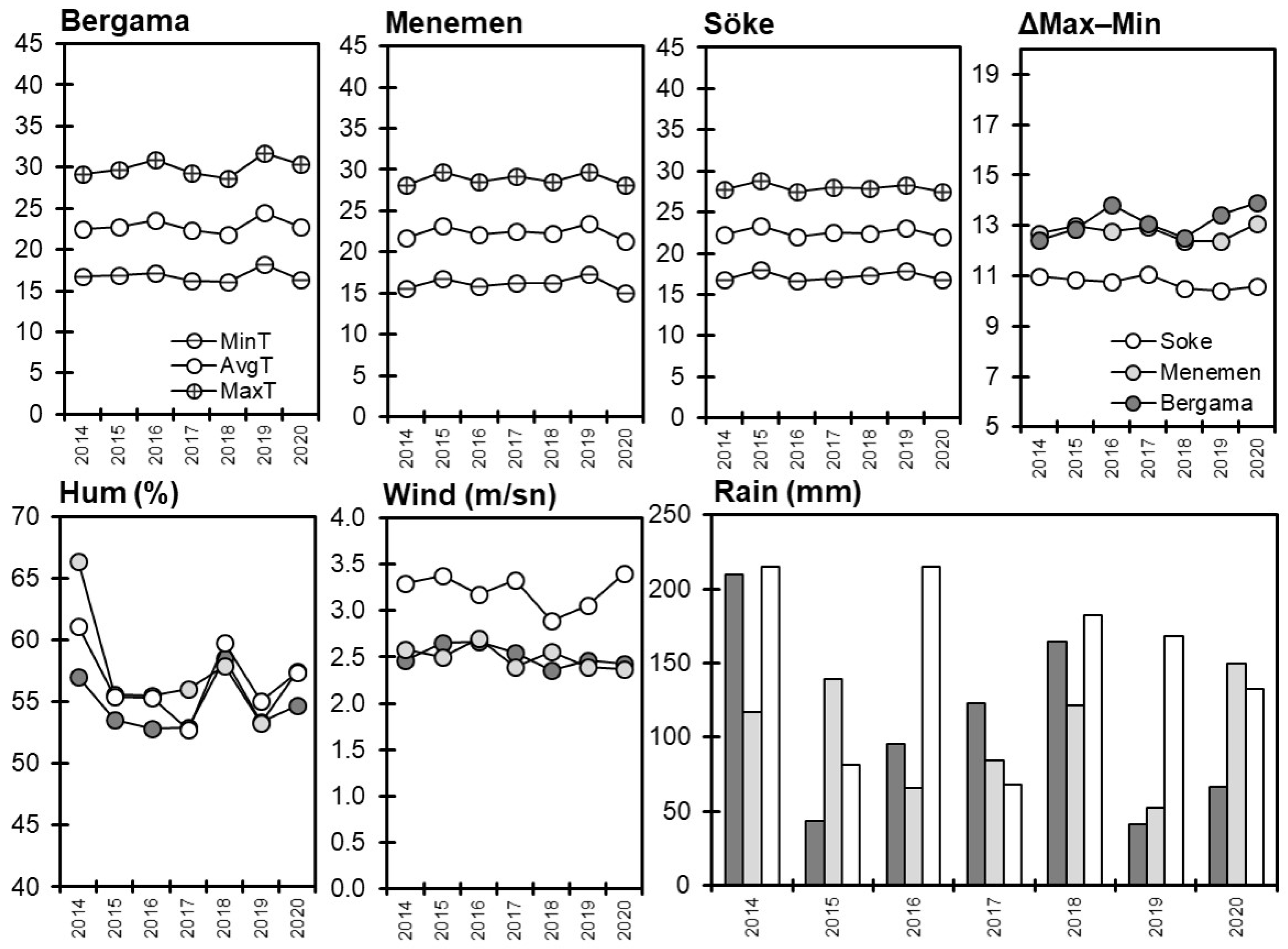

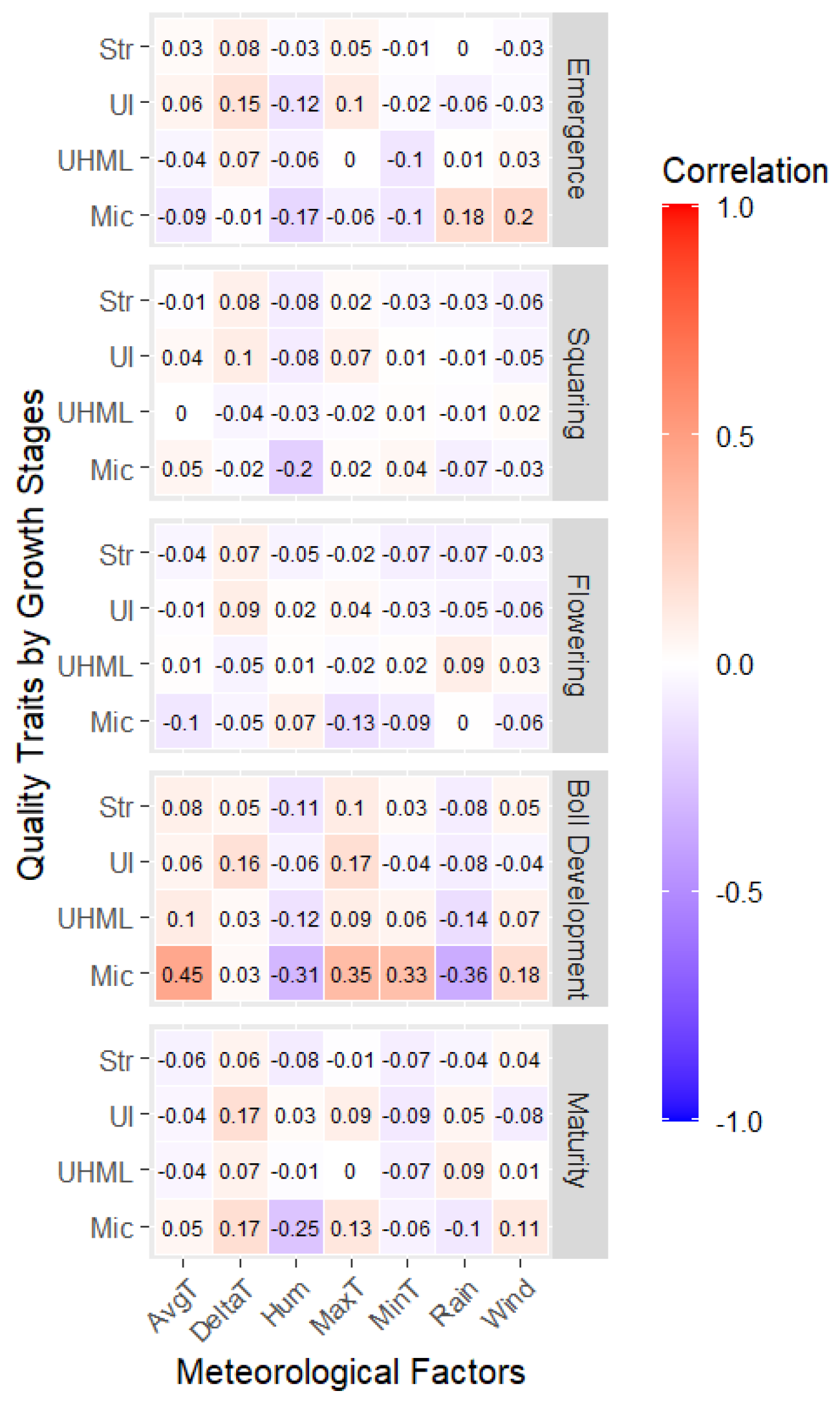
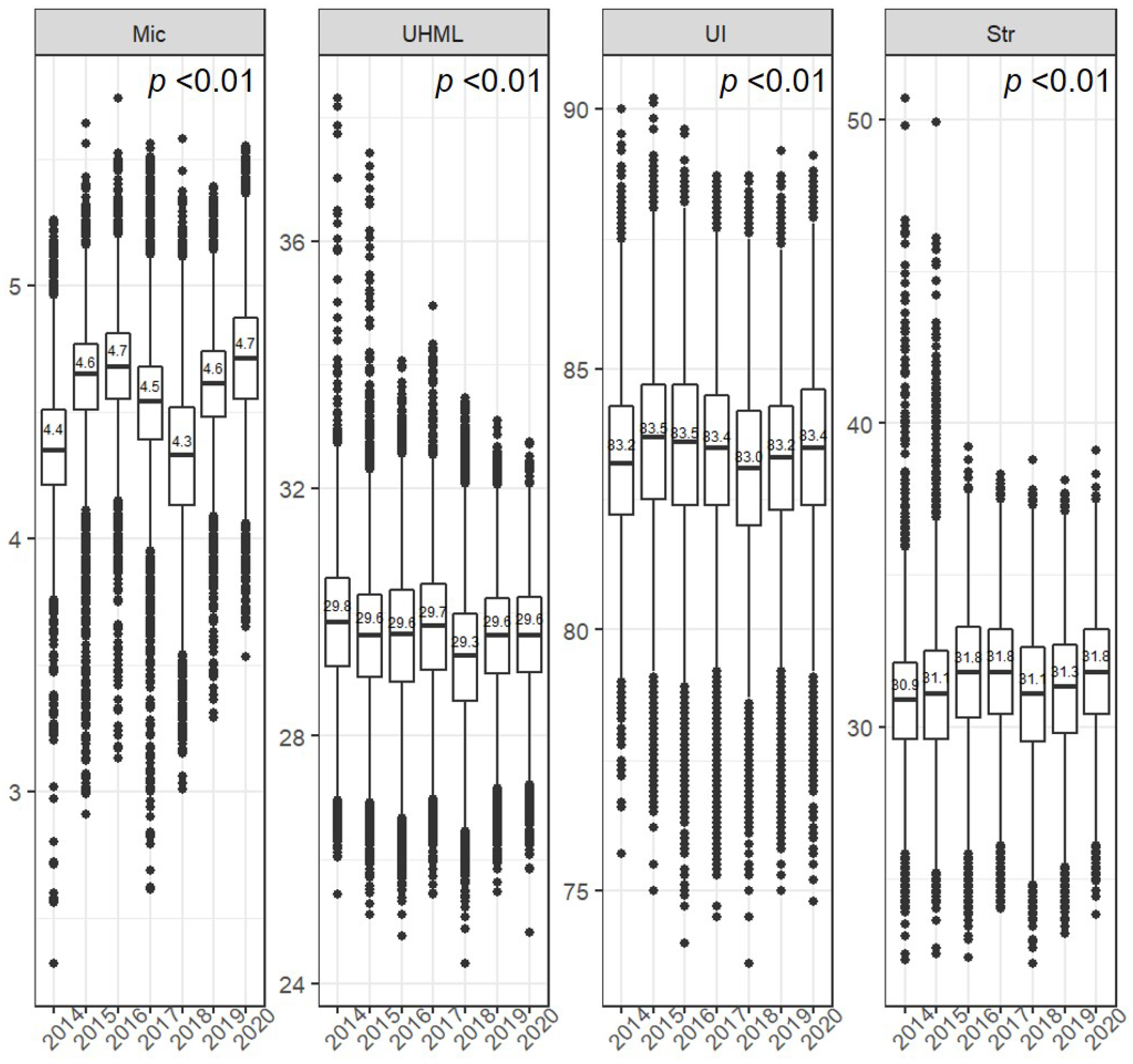
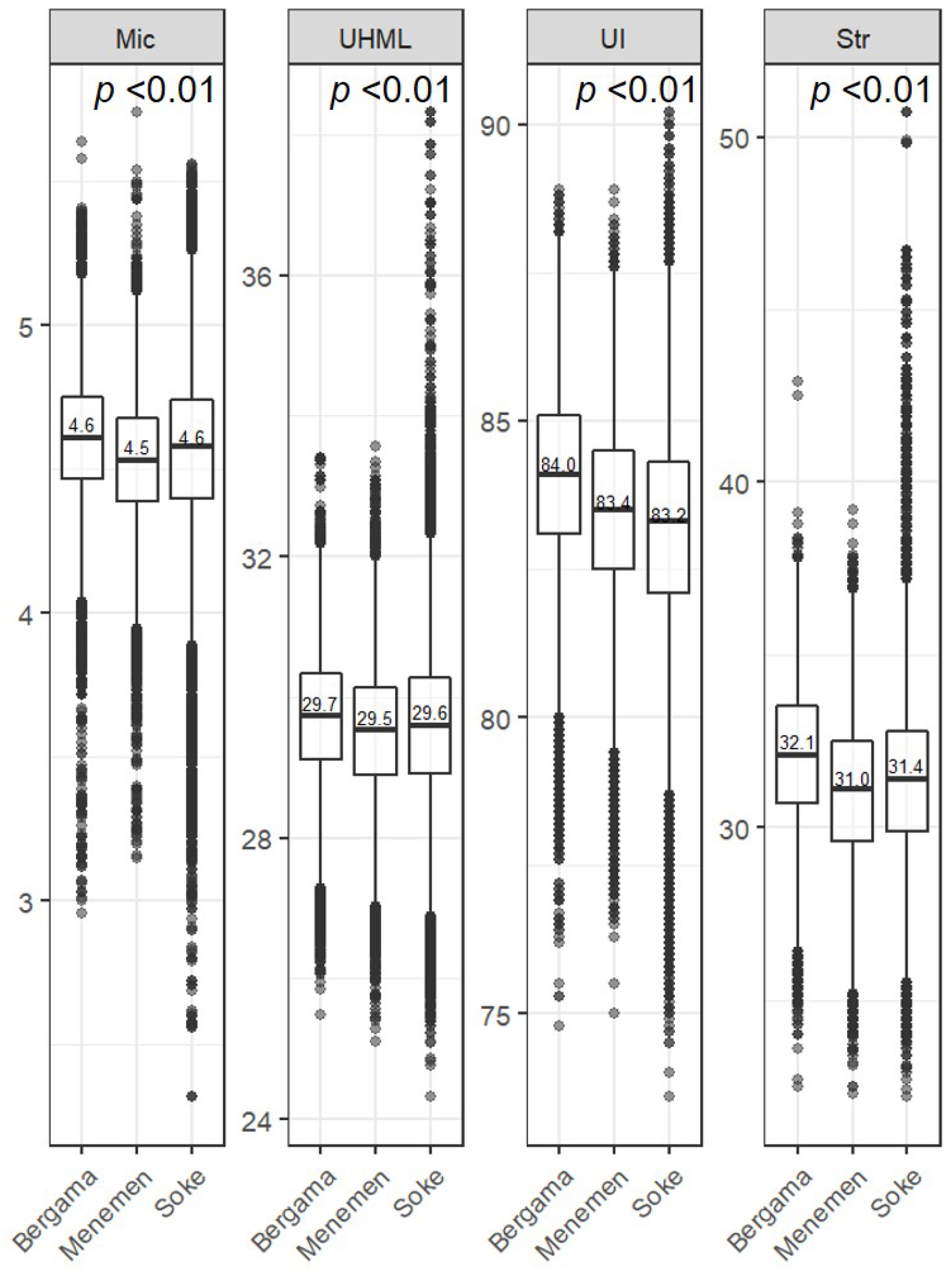
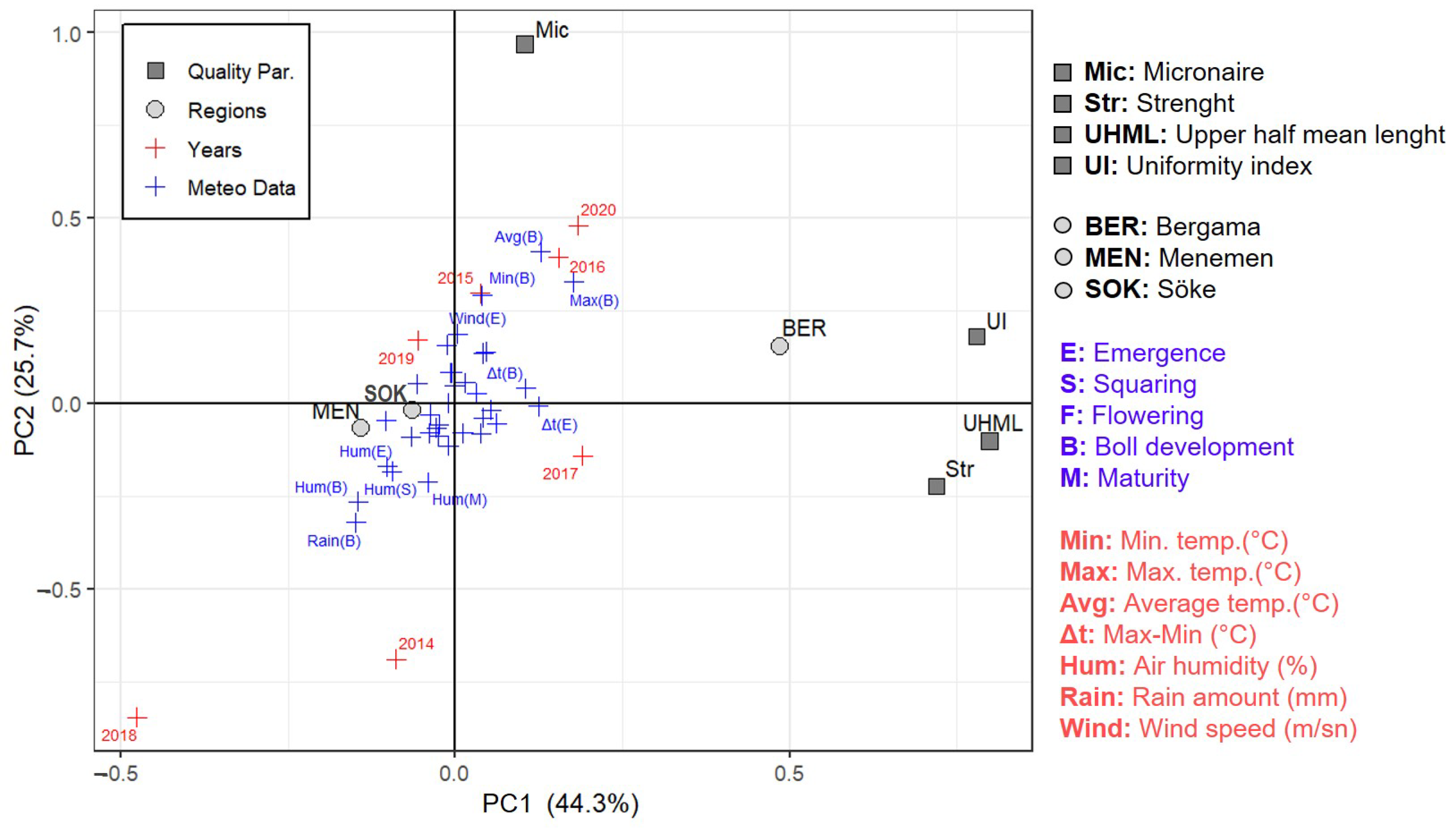
| Model Parameter | Mic | Str | UI | UHML |
|---|---|---|---|---|
| Model p-value | <2.2 × 10−16 | <2.2 × 10−16 | <2.2 × 10−16 | <2.2 × 10−16 |
| Adjusted R2 | 0.274 | 0.055 | 0.055 | 0.051 |
| RSE | 0.225 | 2.098 | 1.602 | 0.985 |
Disclaimer/Publisher’s Note: The statements, opinions and data contained in all publications are solely those of the individual author(s) and contributor(s) and not of MDPI and/or the editor(s). MDPI and/or the editor(s) disclaim responsibility for any injury to people or property resulting from any ideas, methods, instructions or products referred to in the content. |
© 2024 by the authors. Licensee MDPI, Basel, Switzerland. This article is an open access article distributed under the terms and conditions of the Creative Commons Attribution (CC BY) license (https://creativecommons.org/licenses/by/4.0/).
Share and Cite
Istipliler, D.; Ekizoğlu, M.; Çakaloğulları, U.; Tatar, Ö. The Impact of Environmental Variability on Cotton Fiber Quality: A Comparative Analysis of Primary Cotton-Producing Regions in Türkiye. Agronomy 2024, 14, 1276. https://doi.org/10.3390/agronomy14061276
Istipliler D, Ekizoğlu M, Çakaloğulları U, Tatar Ö. The Impact of Environmental Variability on Cotton Fiber Quality: A Comparative Analysis of Primary Cotton-Producing Regions in Türkiye. Agronomy. 2024; 14(6):1276. https://doi.org/10.3390/agronomy14061276
Chicago/Turabian StyleIstipliler, Deniz, Müge Ekizoğlu, Uğur Çakaloğulları, and Özgür Tatar. 2024. "The Impact of Environmental Variability on Cotton Fiber Quality: A Comparative Analysis of Primary Cotton-Producing Regions in Türkiye" Agronomy 14, no. 6: 1276. https://doi.org/10.3390/agronomy14061276
APA StyleIstipliler, D., Ekizoğlu, M., Çakaloğulları, U., & Tatar, Ö. (2024). The Impact of Environmental Variability on Cotton Fiber Quality: A Comparative Analysis of Primary Cotton-Producing Regions in Türkiye. Agronomy, 14(6), 1276. https://doi.org/10.3390/agronomy14061276





